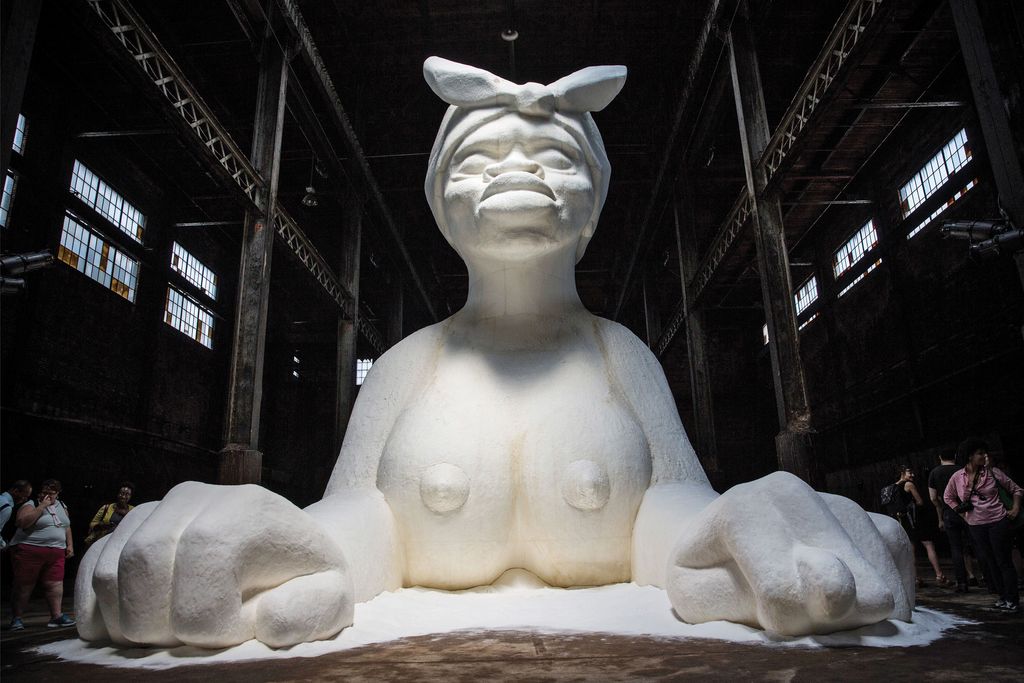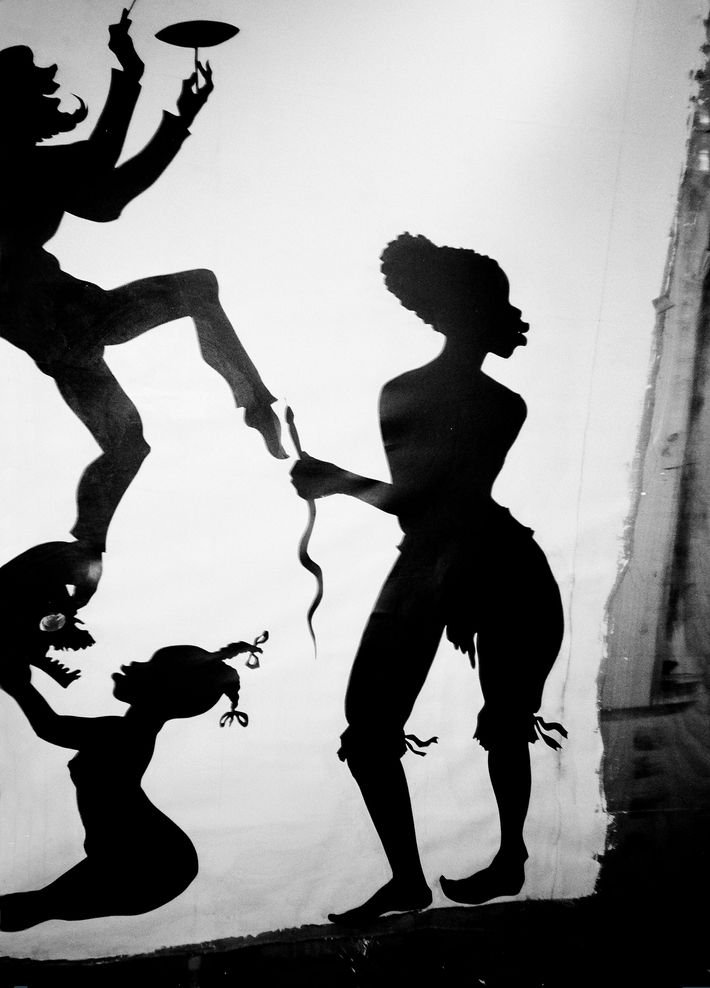"Commissioned by the downtown public-art fund Creative Time, A Subtlety, or the Marvelous Sugar Baby induced, like any Kara Walker work, an equivocal ceremony of looking — who looks, at what, and how. The central sculpture — a Sphinx creature with the kerchiefed head of a mammy figure, her breasts naked, her vulva prominent — stood 35 feet by 75 feet, a chimera of unvarnished American desires, protected by an infantry of black-boy figurines carrying agricultural bounty, built from Walker’s sketches by a team of nearly 20 fabricators, the 3-D sculpting and milling firm Digital Atelier, and Sculpture House Casting. A foam skeleton overlaid with 40 tons of sugar, water, and resin, the Sugar Baby was the largest single piece of public art ever erected in New York City. It was also one of the biggest in another sense: The show attracted 130,000 visitors, briefly lived a convoluted life as a coveted social-media geo-tag, and seemed, given the many pilgrims it enticed, to herald a new future for public art in the city. As Nato Thompson of Creative Time told me, “Kara immediately understood what a different form public art can be.”

- og fra lidt længere nede i artiklen, om kritikken af hendes brug af sorte stereotyper:
"Today, Walker keeps that issue of International Review on her bookshelf, along with another work called Kara Walker—No/Kara Walker—Yes/Kara Walker—?,
published in 2009. “What are they debating, really? My right to exist?”
she asks. “I was getting a lot of letters and phone calls. People were
concerned about me. They were excited to see the work but also concerned
about the endemic racism of the gallery system, that I might be
swallowed up and spat out by a gallery because of the sensationalistic
quality of the work,” Walker says of the mid-1990s. “I created this
space where I as the artist was also the Negress who is to some extent
living in the master’s house or vying for the master’s attention.”

Walker
has played with this provocation — of figuration versus personhood, and
the relationship of her own identity to those bodies depicted in her
work — ever since. She sometimes refers to herself as a “Negress of
noteworthy talent,” a reference to the slave girl-child character Hilton
Als once identified as the “saint figure” of her compositions. She
looks to the languid narrators of southern novels like Gone With the Wind
for the flamboyance and piquancy of her drawings. To Walker, art is
description, not advertisement. To those who say she might be
politically alienated, or that she doesn’t exhibit much black
allegiance, Walker more or less agrees. “I recognize it when I see it in
other people, and I recognize it in myself. Even my dealer [Brent
Sikkema] would say, ‘People would reach out to you and you seemed to be
someplace else.’ I’m older now, but I really lacked empathy in a way I
did not realize. Desensitized. Not fully grasping … the ‘positivity’ of
black life and looking more closely at cruel native spaces. But I do
that because I’ve lived in that space quite a lot.”
“I’m sure she knows the difference between herself and the Sugar Baby,”
says Hannaham. “She knows that her work and persona is a lightning rod
for what she calls ‘the pathologies’ that are everywhere in the country.
But she also knows that putting a naked representation of a black woman
in a public space invites all sorts of projections, bullshit, and
reverence. She likes that.”

“Many black artists do prefer to make affirming images,” says historian Nell Irvin Painter, author of (among other things) The History of White People. “But
many others want to make whatever images their eyes take them to,
whether affirming or not affirming.” The controversy remains a live one.
In 2013, Painter and Walker participated in a public dialogue following
a controversy at the Newark Public Library. Scott London had sent
Walker’s graphite drawing the moral arc of history ideally bends
toward justice but just as soon as not curves back around toward
barbarism, sadism, and unrestrained chaos to the library on loan.
Its loquacious, literary titling belies the overtness of its chaos:
floating figures engaged in states of amoral hygiene. A figure of
President Obama wags a condemning hand over a podium, a naked black man
clutches a fleeing figure, and the head of a black woman is forced into a
white man’s crotch. Employees at the library decided to cover the
painting with a sheet.
“It’s
funny, there’s a way in which the accusation of stereotype reveals more
of how their eyes work versus how my work works,” Walker says. “I
wouldn’t make art if it were purely an ego-driven exercise.” Then,
calmly, she moves in another rhetorical direction. “If the work is
reprehensible, that work is also me, coming from a reprehensible part of
me. I’m not going to stop doing it because what else could I do?""

Ingen kommentarer:
Send en kommentar